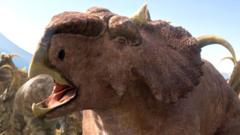Deep beneath the emerald slopes of Alberta, Canada, lies a grave on an extraordinary scale—a mass dinosaur grave that encapsulates an age-old mystery. Scientists have flocked to the Pipestone Creek, fittingly dubbed the "River of Death." Their mission is to unravel how countless dinosaurs met their end 72 million years ago.
The investigation begins with the arduous task of breaking through the thick rock that encases a treasure trove of fossilized bones. Professor Emily Bamforth leads the excavation, noting the exciting find of a hip bone from a Pachyrhinosaurus amidst an intricate collection of ribs and toe bones. With warnings from her loyal dog Aster—the unofficial bear-spotter—she meticulously lifts layers of dirt, unveiling the remnants of an ancient ecosystem.
Documented in a new BBC series, "Walking With Dinosaurs," the fossils found here belong to the Pachyrhinosaurus, a hefty relative of the Triceratops. Weighing around two tons and measuring approximately five meters long, these herbivorous creatures are characterized by large bony frills and three horns. Professor Bamforth estimates that up to 300 bones can be found in every one square meter, generating excitement among the researchers who have only started excavating an area the size of a tennis court, while the bone bed extends for a staggering kilometer.
This abundant fossil deposit offers more than just bones; it provides a snapshot of a single species' communal history, an almost unprecedented find in the fossil record. Researchers believe the gang of Pachyrhinosaurus was on a seasonal migration from southern regions to summer pastures when disaster struck. The warmer climate of that era nurtured lush vegetation, allowing these dinosaurs to thrive en route to their destination.
In a separate expedition two hours away, at the Deadfall Hills, the research team discovered even larger dinosaur bones that offer additional context about the area’s wildlife. Palaeontologist Jackson Sweder notes the presence of Edmontosaurus skull fragments, leading to revelations about this herbivore’s lifestyle and interactions with fellow dinosaurs like the Pachyrhinosaurus.
The crucial puzzle piece remains: what caused the massive die-off? Professor Bamforth hypothesizes that a catastrophic event—likely a flash flood precipitated by a severe storm—effaced much of this herd. The sheer mass and top-heaviness of the Pachyrhinosaurus rendered them ill-prepared for such a sudden onslaught of water.
The sediments at the site provide whispers of this tragedy, captured in the geological record as swirling patterns within rocks. The contrast of this devastating event has paved the way for monumental discoveries, capturing the imaginations of palaeontologists who return year after year, knowing they’ll unearth more bones.
As they gather their equipment and prepare to leave, the researchers remain invigorated. Each visit to Pipestone Creek is a promise of new findings, adding layers of understanding to the lives of these prehistoric giants that once roamed the earth during a much different era. The excavation continues, and with it the quest to unveil the long-buried secrets of the past. The new series "Walking With Dinosaurs" will launch on Sunday, May 25, at 18:25 BST on BBC One.



















